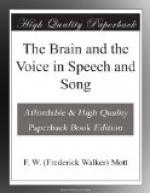is the main force employed in normal breathing and
to some extent in vocalisation (for it keeps up a
constant steady pressure), the mind, by exercising
control over the continuance of elevation of the ribs
and contraction of the abdominal muscles, regulates
the force of the expiratory blast of air so as to employ
the bellows most efficiently in vocalisation.
Not only does the contraction of the abdominal muscles
permit of control over the expulsion of the air, but
by fixing the cartilages of the lowest six ribs it
prevents the diaphragm drawing them upwards and
inwards
(
vide fig. 2). The greatest expansion
is just above the waistband (
vide fig. 3).
We are not conscious of the contraction of the diaphragm;
we are conscious of the position of the walls of the
chest and abdomen; the messages the mind receives relating
to the amount of air in the bellows at our disposal
come from sensations derived from the structures forming
the wall of the chest and abdomen,
viz. the position
of the ribs, their degree of elevation and forward
protrusion combined with the feeling that the ribs
are falling back into the position of rest; besides
there is the feeling that the abdominal muscles can
contract no more—a feeling which should
never be allowed to arise before we become conscious
of the necessity of replenishing the supply of air.
This should be effected by quickly drawing in air through
the nostrils without apparent effort and to as full
extent as opportunity offers between the phrases.
By intelligence and perseverance the guiding sense
which informs the singer of the amount of air at his
disposal, and when and how it should be replenished
and voluntarily used, is of fundamental importance
to good vocalisation. Collar-bone breathing is
deprecated by some authorities, but I see no reason
why the apices of the lungs should not be expanded,
and seeing the frequency with which tubercle occurs
in this region, it might by improving the circulation
and nutrition be even beneficial. The proper
mode of breathing comes almost natural to some individuals;
to others it requires patient cultivation under a teacher
who understands the art of singing and the importance
of the correct methods of breathing.
The more powerfully the abdominal muscles contract
the laxer must become the diaphragm muscle; and by
the law of the reciprocal innervation of antagonistic
muscles it is probable that with the augmented innervation
currents to the expiratory centre of the medulla there
is a corresponding inhibition of the innervation currents
to the inspiratory centre (vide fig. 18, page
101). These centres in the medulla preside over
the centres in the spinal cord which are in direct
relation to the inspiratory and expiratory muscles.
It is, however, probable that there is a direct relation
between the brain and the spinal nerve centres which
control the costal and abdominal muscles independently
of the respiratory centres of the medulla oblongata




